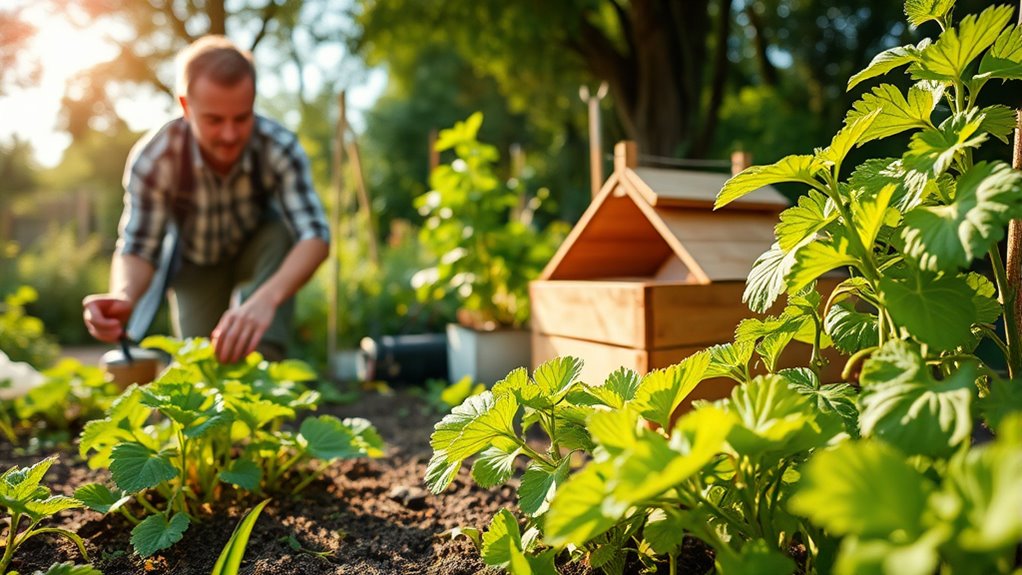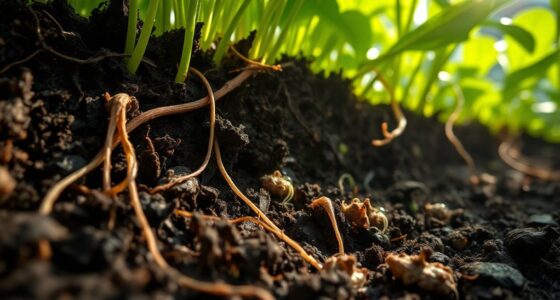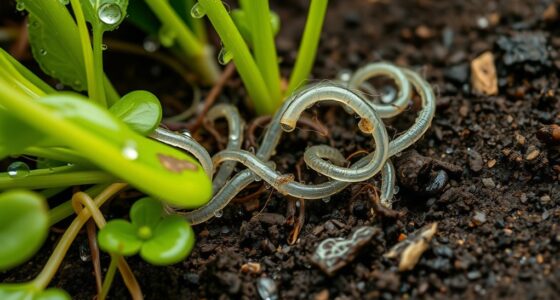Integrated Pest Management (IPM) is a smart way to keep pests under control in your garden while protecting the environment. It combines natural methods like biological controls—using beneficial insects—and cultural practices such as crop rotation, pruning, and weed removal. This approach helps prevent pests from becoming a problem and reduces your reliance on chemical pesticides. If you want to create a healthier, more resilient garden, discovering more about IPM techniques will help you get started.
Key Takeaways
- IPM combines biological, cultural, and mechanical methods to control pests sustainably and reduce chemical pesticide use.
- It uses natural enemies like beneficial insects to keep pest populations in check without harming pollinators.
- Cultural practices such as crop rotation, proper spacing, and weed removal prevent pest establishment and promote plant health.
- IPM emphasizes prevention and monitoring to manage pests early and efficiently, minimizing environmental impact.
- Combining these strategies creates a resilient garden ecosystem that maintains pest levels at manageable, eco-friendly levels.

Have you ever wondered how farmers and gardeners keep pests under control without relying solely on chemicals? The answer lies in integrated pest management, or IPM. This approach combines various strategies to manage pests effectively while minimizing environmental impact and reducing reliance on pesticides. One of the key components of IPM is the use of biological controls. These involve introducing natural enemies of pests—like beneficial insects, mites, or pathogens—to keep pest populations in check. For example, releasing ladybugs to control aphids or using parasitic wasps to target caterpillars are common biological control methods. These natural predators help maintain a balance in your garden, preventing pests from reaching damaging levels without harming beneficial insects or pollinators.
Alongside biological controls, cultural practices play a vital role in IPM. These are adjustments you make to your gardening routines and environment to make it less hospitable for pests. Crop rotation, for example, involves changing planting locations each season to prevent pests from establishing themselves. Proper spacing and pruning improve air circulation, reducing conditions that favor many pests and diseases. Selecting pest-resistant plant varieties is another cultural practice that can greatly reduce pest problems. Additionally, you can remove weeds and debris that harbor pests or serve as breeding grounds for insects. Keeping your garden clean and healthy not only discourages pests but also promotes stronger plants that can better withstand infestations.
Cultural practices like crop rotation, pruning, and weed removal help make gardens less attractive to pests.
By combining biological controls and cultural practices, you create a multi-layered defense system. Instead of using chemicals as a first line of attack, you focus on prevention and natural management techniques. This integrated approach helps protect your plants while safeguarding beneficial insects, pollinators, and the environment. It also reduces the risk of pests developing resistance, a common problem with overreliance on chemical pesticides. Plus, implementing these practices often leads to healthier, more resilient plants, which can better fend off pests on their own.
In essence, understanding and applying biological controls and cultural practices is fundamental to successful IPM. These methods work together to keep pest populations at manageable levels, promoting a sustainable and environmentally friendly gardening approach. When you adopt IPM, you’re not just dealing with pests—you’re fostering a healthier ecosystem where plants, beneficial insects, and humans coexist harmoniously. This holistic view helps you achieve a productive and enjoyable garden while minimizing harm to the planet. Incorporating antique elements into your garden design can also enhance its charm and create a more inviting environment for beneficial insects and pollinators.
Frequently Asked Questions
How Does IPM Differ From Traditional Pest Control Methods?
You’ll notice that IPM differs from traditional pest control because it reduces chemical dependence, relying on multiple strategies instead of just pesticides. This approach helps prevent pest resistance, which often happens with repeated chemical use. IPM focuses on monitoring pests, using biological controls, and applying chemicals only when necessary. By doing so, you protect your garden’s health and the environment, making pest management more sustainable and effective in the long run.
Are Organic Methods Always Effective in IPM?
Organic methods can sometimes be as powerful as a tidal wave, but their effectiveness isn’t guaranteed. While natural methods like neem oil or beneficial insects often work well, their organic effectiveness varies depending on pests, environment, and timing. You shouldn’t rely solely on organic techniques in your IPM plan; combining them with other strategies ensures better pest control. Remember, no single approach is a silver bullet—success depends on integrated efforts.
What Are the Initial Costs of Implementing IPM?
When you consider the initial costs of implementing IPM, cost considerations and budget planning are key. While some tools like monitoring traps or organic treatments may have upfront expenses, these are often offset by long-term savings. You might need to invest in education or new equipment, but careful planning helps manage costs effectively. Overall, IPM can be cost-efficient, especially when you prioritize sustainable practices that reduce pesticide use.
Can IPM Be Used for Indoor Gardening?
Imagine discovering pests in your indoor garden—panic sets in. The good news? IPM can be your secret weapon for indoor pest control and greenhouse management. It’s flexible enough to adapt to your space, using eco-friendly methods to target pests without harming your plants or your family. With careful monitoring and natural solutions, you can keep your indoor garden healthy, thriving, and pest-free—no matter how small or large your setup.
How Long Does It Typically Take to See Results With IPM?
You’ll start noticing results in a few days to a couple of weeks, depending on pest severity and treatment. Regular pest monitoring helps you track progress, while adjusting your treatment timeline guarantees effectiveness. Consistency is key; early detection and prompt action speed up results. With patience and proper monitoring, you’ll see fewer pests over time, restoring balance to your garden and making your IPM efforts truly successful.
Conclusion
By embracing integrated pest management, you become the diligent guardian of your garden’s delicate balance. Imagine your plants thriving beneath a canopy of natural defenses, free from the chaos of unchecked pests. With thoughtful strategies and a keen eye, you craft a vibrant, harmonious oasis where nature’s rhythms flourish. This gentle dance between intervention and restraint transforms your garden into a resilient sanctuary—beautiful, healthy, and teeming with life.









